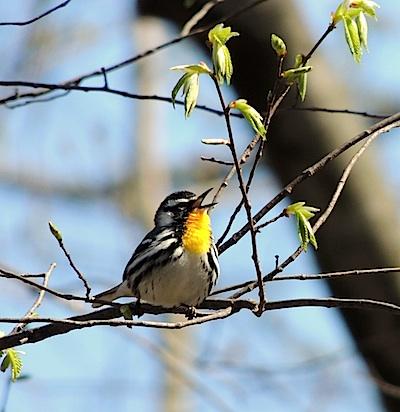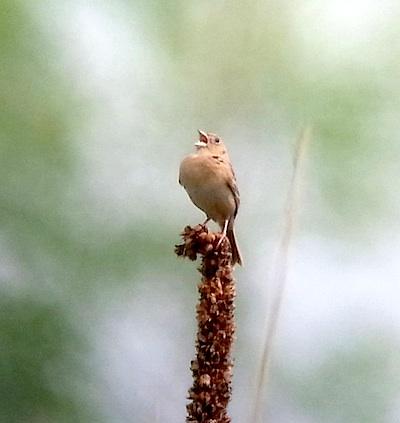
Yellow-throated Warblers can be spotted "by ear" even if you're not musically inclined./Kirby Adams
When I was first learning the basic skills of birding, I read a line in Roger Tory Peterson's famous field guide that almost made me want to give up any aspirations of becoming a good birder. He said something about skilled birders sometimes doing 95 percent of their birding by ear. I was horrified. Here I was, looking through a field guide, imagining all of the pretty birds I would see some day, and Peterson was telling me I'd learn to do 95 percent of it by sound. That's no fun at all!
It didn't help then, and still doesn't today, that I'm tone-deaf and have no innate musical ability. Musically inclined birders seem to pick up ear-birding with an ease the rest of us cannot. My wife is a musician and can pick out a subtle and unassuming buzz of a Blue-winged Warbler from a cacophony of morning birdsong the same way I've seen her key in on what a particular clarinet is doing in a symphony recording. I'll never be that good.
Still, I took a walk on the last morning of May and listed 38 birds. I actually saw eight of them - four of them were decent looks. Only two birds on the entire walk were seen before being tracked by voice. That is summer birding. That's birding by ear. That's what Roger Tory Peterson said would happen.
Unless you're content to look at nothing but hawks and herons your entire birding career, ear-birding is the single most important skill to master. I haven't done that yet, but I assure you it's critical, especially in June. The leaves are fully out in most deciduous forests, and the birds are either in the canopy or the bushy undergrowth, with no intention of being seen. But they need to mark their territory, and thus they sing.
Even if your birding patch of choice isn't leafy, learning songs will help you list many birds that would otherwise remain unknown. Grassland sparrows are a great example. In Theodore Roosevelt National Park, grassland birds can be exceedingly difficult to locate. In a walk at Buck Hill, I was hearing all manner of insects and even noise from other visitors when something different caught my ear. It sounded like an insect, with a clicking and buzz.

A Grasshopper Sparrow caught with the ear/Kirby Adams
A year earlier I would have presumed it was a grasshopper, but on this trip I knew it to be a Grasshopper Sparrow. The previous spring I'd been sitting in a field in Michigan hearing that sound and wondering if it might possibly be a bird. After more than an hour of tracking it, a Grasshopper Sparrow popped up and belted out his grasshoppery song. The image of the bird and the weird song were imprinted in my mind. I listened to MP3s of their song and learned some of the variations as well. All of that 'practice' is why I stopped dead in my tracks on Buck Hill, spun to my right, and put binoculars right on a beautiful Grasshopper Sparrow for the less than two seconds he remained visible.
I'd seen experienced birders pull off things like that before and I thought it was magic. Now that I was doing it, I realized it was just plain old training. I was still proud of myself, though.
Learning songs is daunting if you decide to listen to recordings over and over until they're burned into your brain. I know some young birders who have an incredible mastery of song after just a few years of birding by using that method, but these are people willing to listen to birdsong on an iPad and headphones while walking to class, waiting at a bus stop, making dinner, etc. That works, but it can be a lot like hard work.
You can learn in the field. It takes longer, but I think it makes a more lasting impression. When you hear a song, track it down, and see the bird, you have visual images and memories of the hunt to go along with the sound. That combination makes learning far easier.
I had to find out who was singing a buzzy, warbling song one morning in Blackwater Falls State Park in West Virginia. Peterson calls this song 'lisping and dreamy.' The authors of the new Warbler Guide represent it as 'Suzy's at the zoo, see?' Both are useful descriptions, but it's different for me. Every time I hear that song, I see myself clamoring over granite boulders under a canopy of hemlock and fir, finally crawling atop a particularly large rock and catching the bird singing. It was the very common Black-throated Green Warbler, of course. Years later, when I hear the song, I see that bird in my head. I also feel the scraped elbows I got during my descent from the rock. All of that sensory input has made the song unforgettable.
And so it is, bird by bird, that I can walk through a forest in the Midwest in June and not be stumped by much.
Last spring, I did some 'brute force' training when going in search of Yellow-throated Warblers at Indiana Dunes National Lakeshore. Listening to the song repeatedly on the drive there made enough of an impression that I picked out the singing bird quickly and was in good position to then see them. But apparently the impression didn't last. This spring a Yellow-throated Warbler appeared in my hometown, farther north than they're usually found. I went out to find the bird and show it off to some neophyte birders. I thought the song would strike me right away.
During a half hour of looking for the bird, my companions asked about a singing Tufted Titmouse and the warble of a Tree Swallow. I answer their queries, playing the part of the expert. Then they asked about a bird that was singing off to our left that I had heard and subconsciously discounted as nothing important. I stopped, took out my phone, and very quietly played a Yellow-throated song in my ear so as not to disturb the bird if it was around. No longer looking like an expert, I put my phone back in my pocket and said, 'That would be exactly the bird we've been looking for.'
In another two minutes we had a visual on him, and I'll never forget that song again.



Comments
When I was in Big Bend National Park this past April, I was huffing and puffing up Pinnacles Trail. There were two ladies in front of me (in much better shape) but somehow I would keep catching up to them, because they would periodically stop and stand very still. I was trying to figure out what they were looking at and finally, after catching up to them for about the third or fourth time, I asked them. One of the women turned to me and in hushed tones said they were simply listening to try and distinguish the number of different birds in that area by their birdsong. So I stopped to listen too, and ended up hearing 3 different types of birdsong. Of course, I couldn't id any of them by their song. I wouldn't be able to identify them even by looking at them, but your article brings to mind that one day on the trail.